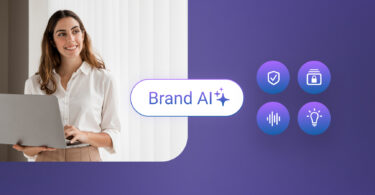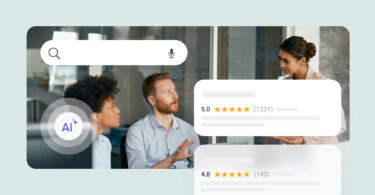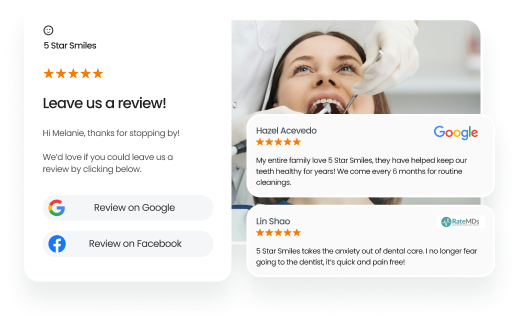Referral code example: Something like SAVE50 or EMILY2025 is easy to remember, simple to share, and designed to reward.
Referral marketing is a powerhouse for business growth. In fact, People naturally trust recommendations from friends and family, which makes referrals one of the most credible and cost-effective ways to drive new traffic and increase sales. That’s why more brands are investing in smart, scalable customer referral programs.
But not every company’s referral program delivers results. Top-performing programs use shareable codes and referral links to create a seamless process for both senders and receivers. Whether it’s a one-time bonus or part of a milestone referral program, the key is to keep it frictionless and rewarding.
Take inspiration from the iconic Dropbox referral program, which turned everyday users into growth engines. When done right, referrals build communities of loyal customers who stick around and spread the word.
An easy-to-use referral marketing program leverages the power of word of mouth to win more clients and grow your business. Moreover, it’s incredibly effective for bringing in new clients consistently.
In this blog, you’ll explore what a referral code is, why it matters, how it compares to referral links, and real-world referral code examples. You’ll also learn best practices for creating your own code, tips to master referral marketing, and how Birdeye can help you grow your referral program with ease.
Table of contents
- What is a referral code?
- How does a referral code work?
- Why do you need a referral code?
- Referral code vs. referral links
- 7 referral code examples
- Craft referral codes that convert: Best practices + pro tips
- How to ace referral marketing with ease?
- Final takeaway: Build trust, get leads, repeat
- FAQs about referral code examples
- Grow your referral program with Birdeye
What is a referral code?
A referral code is a unique identifier shared by existing users to invite others to join a service or platform. For example, a referral ID example could be something like REF12345 or JOHN25, which new users enter during signup to unlock a reward.
When someone uses the code, both the referrer and the new user typically receive rewards like discounts, credits, or other benefits. A well-run referral program turns happy customers into brand advocates while driving growth through personal recommendations.
In a typical referral program, every client joining the program (referrer) gets a unique referral code to share with others to earn rewards.
Your referral request message with a code makes it easy for customers to forward it via text or email to friends and family.Referral codes also allow companies to track a referral’s origin and automatically credit the referrer with a reward, keeping the program efficient and motivating.
Here’s one of the referral code examples that Ibotta uses to incentivize users on its app.
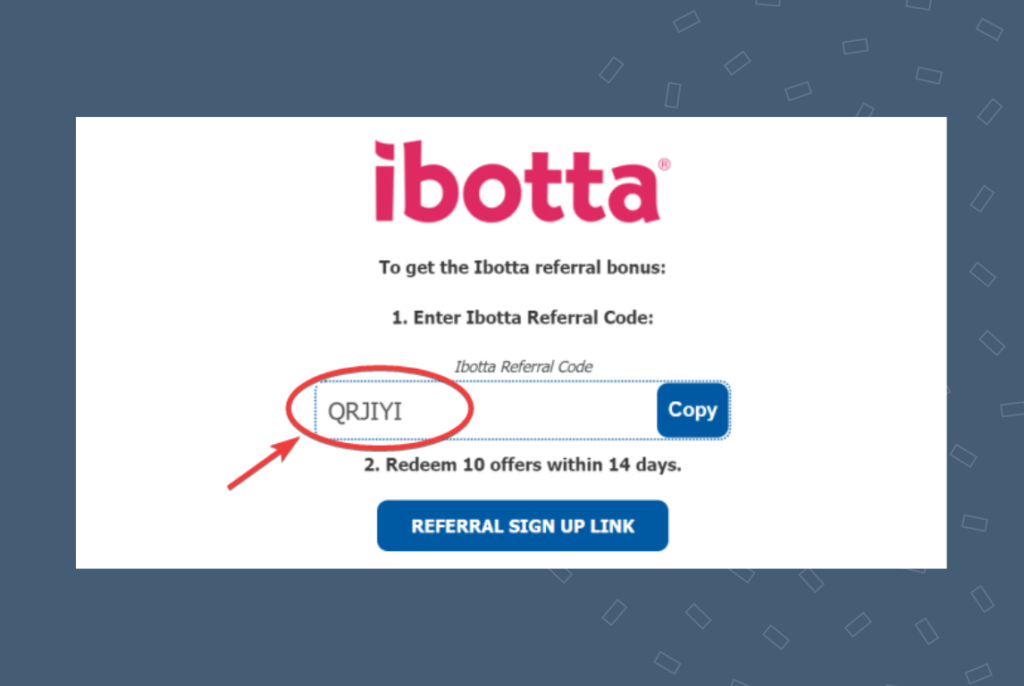
How does a referral code work?
A referral code creates a win-win loop between your brand, your existing customers, and the people they influence. Here’s how it works:
- A happy customer shares their referral code: This could be with friends, coworkers, or family members, anyone they believe would benefit from your product or service.
- The invitee signs up using the code: When new customers use the code during signup or purchase, they’re instantly linked to the referrer.
- Both parties get rewarded: Businesses offer discounts, bonuses, or exclusive access to both referred customers and their referrers, driving participation and conversions.
- Your program tracks every referral: Codes make it easy to attribute referrals and measure results, turning word-of-mouth into real data.
- Loyalty grows with every referral: Well-structured programs, like the ClickUp referral program or the Uptick referral program, don’t just acquire users; they deepen customer loyalty by rewarding advocacy.
- It scales with intention: A willful referral program powered by your existing customer base creates ongoing momentum, not just one-off wins.
When done right, referral codes convert trust into traction and turn customers into your most valuable marketing channel.
Why do you need a referral code?
A referral code can be regarded as more than a marketing tool; it’s the engine that drives successful referral marketing campaigns. It adds structure, clarity, and trust to every refer-a-friend interaction, making it easier for businesses to scale word-of-mouth while keeping customers engaged and rewarded.
Here’s why having a referral code matters:
- It brings structure to your referral program: Without a code, it’s nearly impossible to track how referrals flow through your system. A referral code works by tagging each new signup to a specific user, helping you understand which existing customers are driving the most referrals.
- It ensures fair and accurate reward distribution: With a unique referral link or code, you can instantly identify who referred whom, making it easier to deliver referral rewards to both the referrer and the new customer. This eliminates disputes and builds trust in the program.
- It simplifies the customer experience: Sharing a personal referral link or code is effortless. Whether customers enter it during signup or use it with a coupon for instant perks, it streamlines the refer-a-friend process and makes it intuitive and appealing.
- It boosts customer loyalty and satisfaction: When existing customers see that their efforts are recognized and rewarded without friction, it strengthens their emotional connection to your brand. Seamless rewards increase satisfaction and turn one-time buyers into long-term advocates.
- It helps you measure success and optimize: Referral codes allow businesses to track every referral, analyze conversion rates, and evaluate the ROI of specific referral marketing campaigns. This data empowers better decisions, helping you fine-tune offers and identify top advocates.
- It reinforces branding and shareability: Custom codes like “JANE25” or “SAVEWITHMIKE” are memorable and personal, encouraging users to promote your brand more naturally. This boosts visibility and helps your campaign travel further across channels.
Pro tip: Use Birdeye Referrals to automate and scale your referral marketing. Set triggers after payments or positive reviews, launch custom campaigns throughout the year, or send 1:1 referral requests directly from your inbox; no manual follow-up is needed.
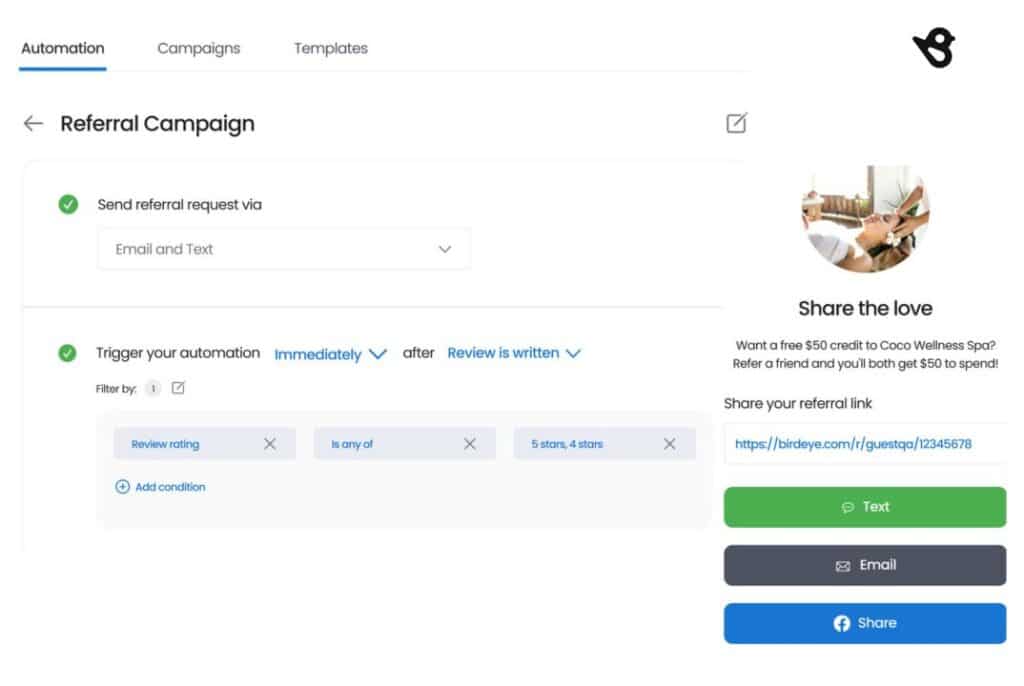
Create easy-to-use codes and set up Referral rewards programs with a few simple steps. Make the best of customer loyalty with Birdeye Referrals.
Referral code vs. referral links
Did you know that even though referral codes and referral links are often used together, they are quite different?
| SI.No | Referral code | Referral link |
| 1 | A referral code is a unique identifier that clients can use to refer and redeem awards. | A referral link refers to an entire link that the referrer shares with friends when participating in the referral program. |
| 2 | A referral code links each customer to the referrals they bring. The code also distributes the rewards they earn from the program. Giving customers access to a referral code makes sharing it with friends and family easier across all devices. Customers can invite their networks quickly and frequently, increasing the program’s success. | A referral link can also help connect the referral code to the customer and the referral. But with referral links, sharing is limited to digital platforms, reducing its impact. |
| 3 | Ideal for in-store usage | Ideal for digital marketing |
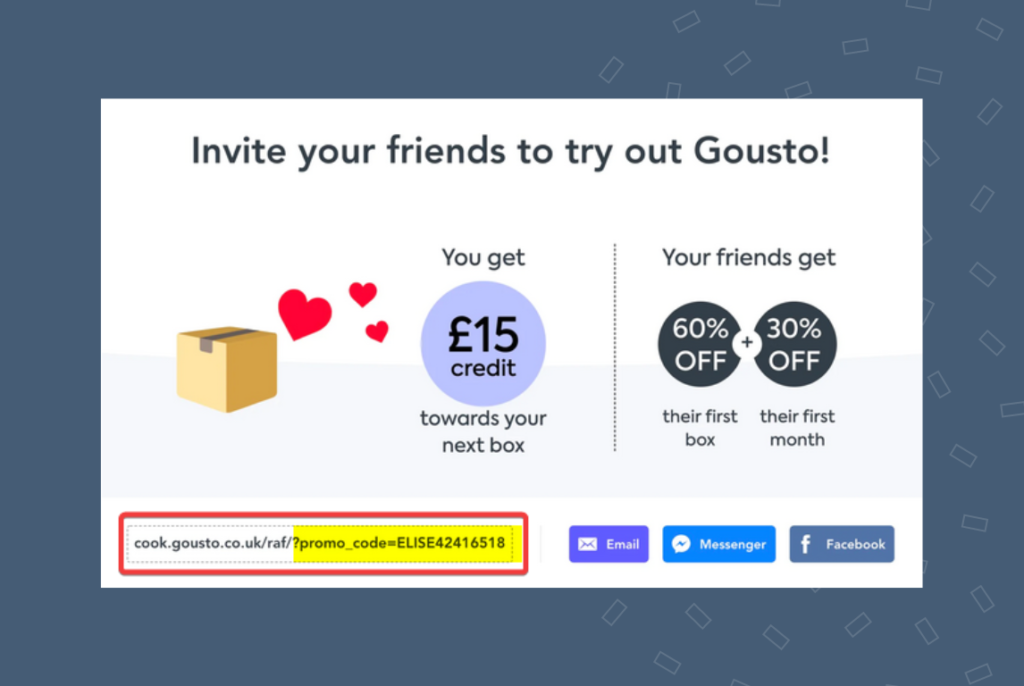
The customer’s referral link is shown in the red box. The text highlighted in yellow is their actual referral code.
7 referral code examples
Looking for real-world referral code examples to guide your strategy? The truth is, what looks effortless often results from years of testing, refining, and investing in the right referral software.
Leading brands didn’t just stumble upon success; they perfected their referral process by understanding what motivates customers and how to use referral codes effectively.
From creative rewards to seamless tracking, each referral ID example reveals how powerful a well-crafted code can be in turning happy customers into growth engines. Let’s explore how top companies do it and what you can learn from them.
Airbnb
This brand has enjoyed staggering growth in just a few short years, thanks to the power of referrals. In this referral code example, the company used a simple referral strategy that incentivized customers with credits for each referral. Referrers would receive a $40 travel credit when new members sign up on Airbnb.
Then, they would receive an additional $20 credit when the referral took their first trip.In the example below, Airbnb combines the user’s name with a series of numbers to create a unique combination of referral code embedded inside a referral link. Customers can just share the unique discount code with their friends and family to enjoy the benefits of Airbnb.
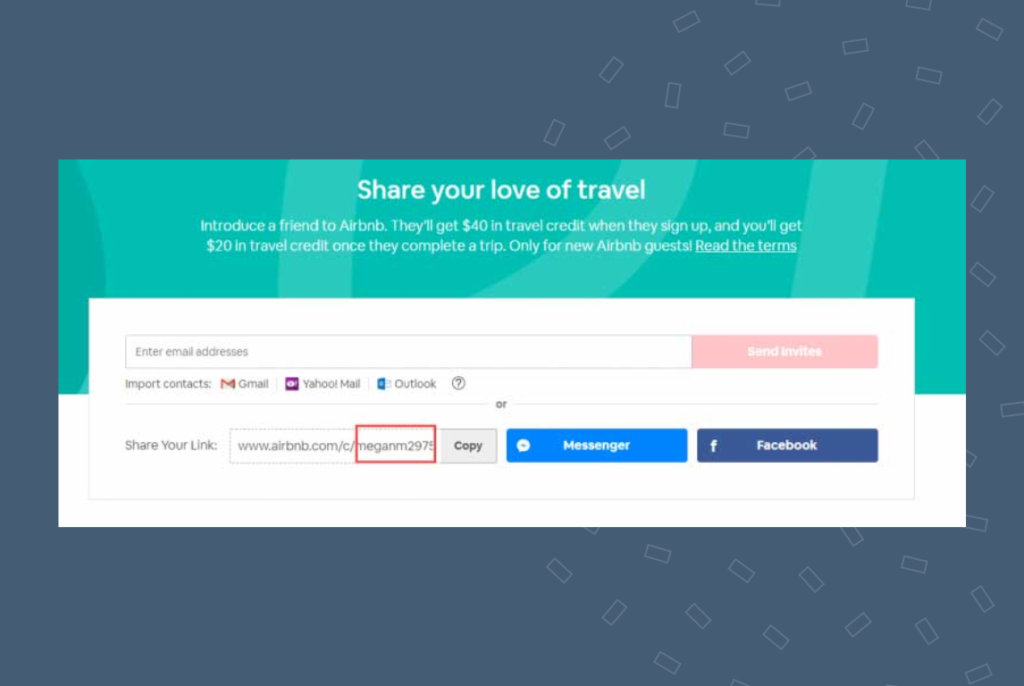
Gymshark
Gymshark is one of the world’s most recognized fitness apparel and accessories brands. It has earned a significant following among fitness enthusiasts and athletes due to its fashionable fitness apparel. Gymshark also utilizes unique referral codes to increase awareness of its products and reward participants for referring new clients.
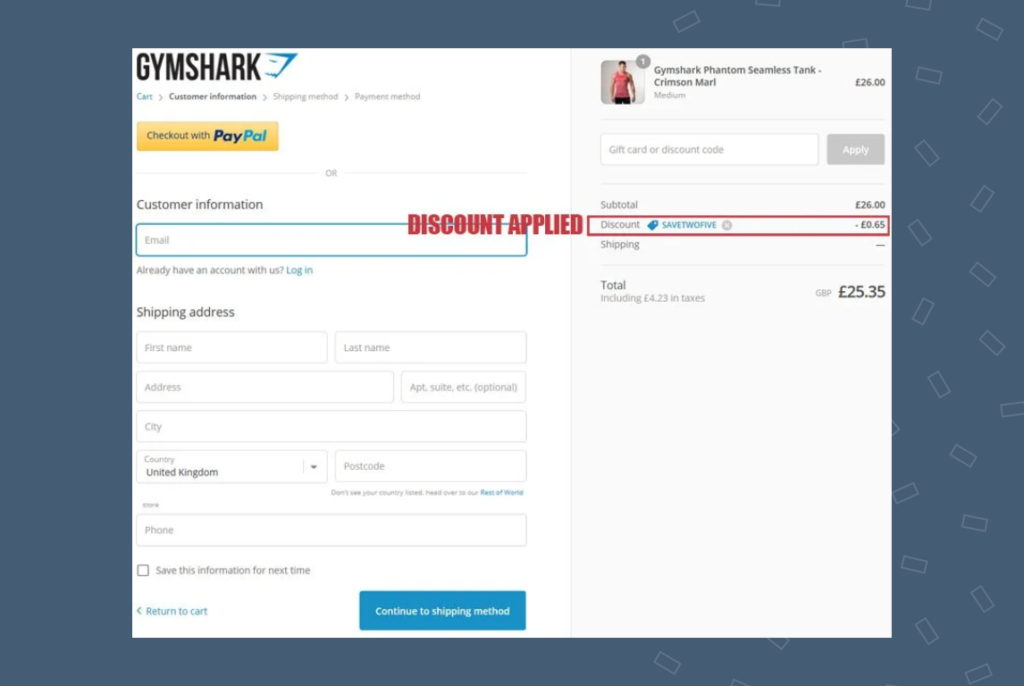
Their referral code is a simple promotional code that the referred client types in at checkout to receive a discount on their purchase. Conversely, the referrer gets a small commission whenever anyone purchases a Gymshark product using their unique referral codes and links.
Dropbox
Dropbox is another classic example of a brand that grew remarkably by starting its own referral program. The brand launched its double-sided referral program, in which both the referrer and the referred client received free storage space. The program boosted signups by a whopping 60% in just 15 months.
After clients sign up for a Dropbox account, they’re automatically assigned a unique referral link to share among friends. And the incentives vary by value. A Dropbox Basic account gets 500 MB per referral, while a Plus account gets 1 GB for every referral.
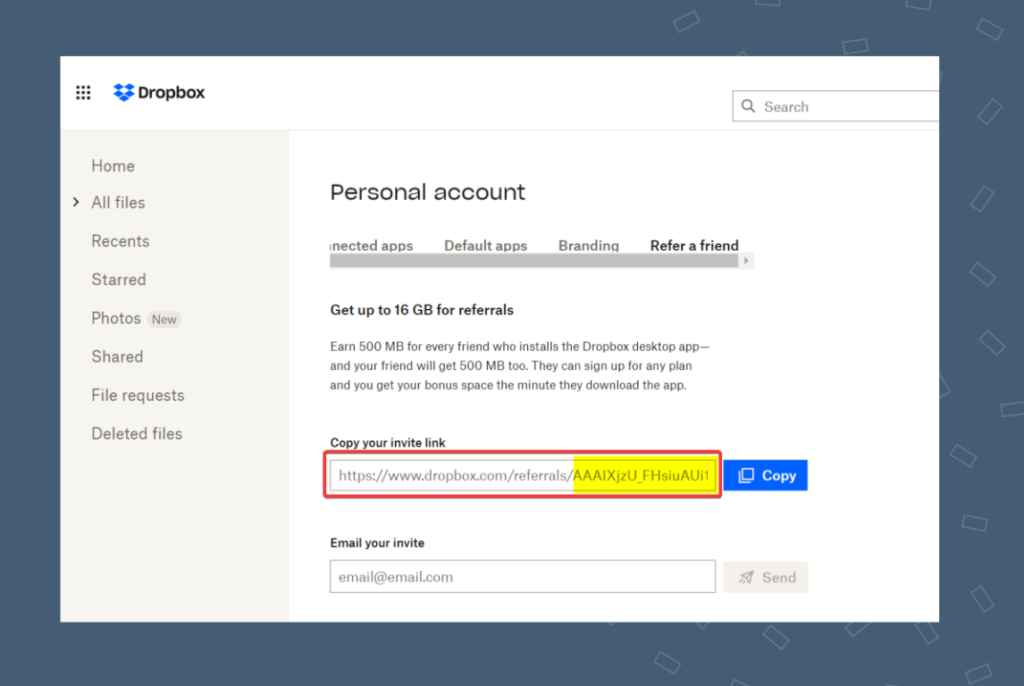
The Dropbox referral unique code (highlighted in yellow) combines lowercase and uppercase letters and random numbers. It is inside a unique referral link to make it easier to share.
Wine Insiders
Wine Insiders is a discount wine delivery service that offers a curated wine selection to its loyal customers. For a discounted price of $20, customers can sample reds, whites, sparkling wine, and rosés. The company uses a subscription-based referral program to grow its client base.
The program incentivizes advocates to share their personalized URLs (PURLs). PURLs use the customer’s name or social media handle to customize referral codes, helping customers remember them easily.
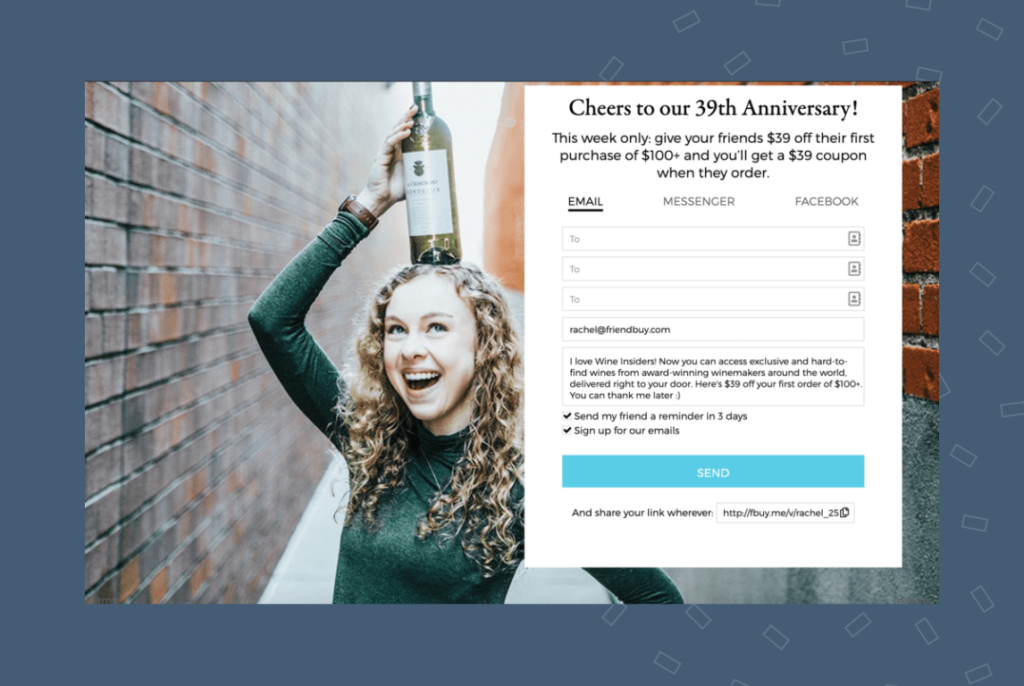
In one of its referral code examples (above,) Wine Insiders executed a highly successful personalized referral program to celebrate its 39th anniversary. Customers get a link with a personalized code to share with friends and family.
The referrer would get a $39 coupon if referred customers purchase using their referral code. The referred client also enjoys a $39 discount off their first purchase, totaling $100 or more.
Flaviar
This brand is a whiskey experience subscription service for customers who want to explore whiskey, vodka, tequila, and personalized spirits. Members pay a $349/year or $109/quarter subscription fee to join the spirit-sampling club.
What makes Flaviar unique, however, is its referral marketing strategy. They incentivize subscribers to become advocates for the brand and refer their friends. Their goal is to build an online community of whiskey lovers and also drive customer engagement.
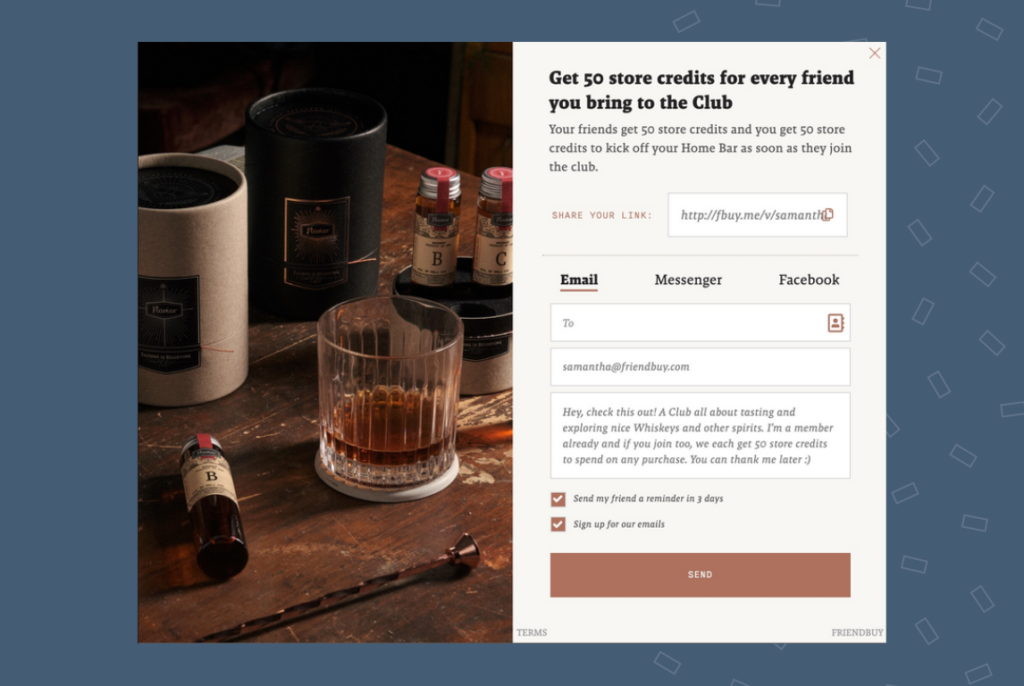
The referral link contains a personalized code and referral links that show the person’s name, making it easy to share with friends and family.
Free Agent
FreeAgent is a cloud-based accounting software business that sends invoices and gentle payment reminders to clients and records expenses. It is specifically aimed at small business owners, contractors, and freelancers. Currently, businesses pay $20 a month to use the platform.
However, with their innovative referral program, business owners can get 10% off their bill for every successful referral. That means if you bring ten users or referred friends to FreeAgent and each referral pays for a subscription, you get 100% off.
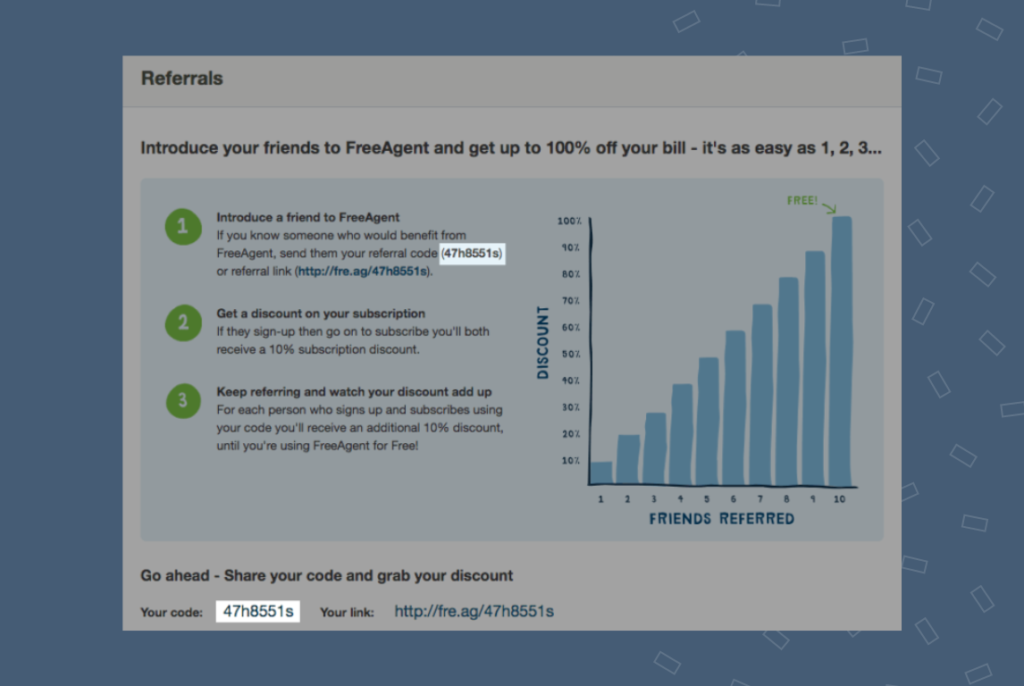
Each FreeAgent gets a unique combination of referral code made up of letters and numbers.
Dollar Shave Club
Dollar Shave Club is a monthly shaving subscription service. When someone joins and creates an account, they’re given a unique referral code to copy and share with friends.
Their referral process offers the existing customer base a $5 bonus credit for each successfully referred friend.
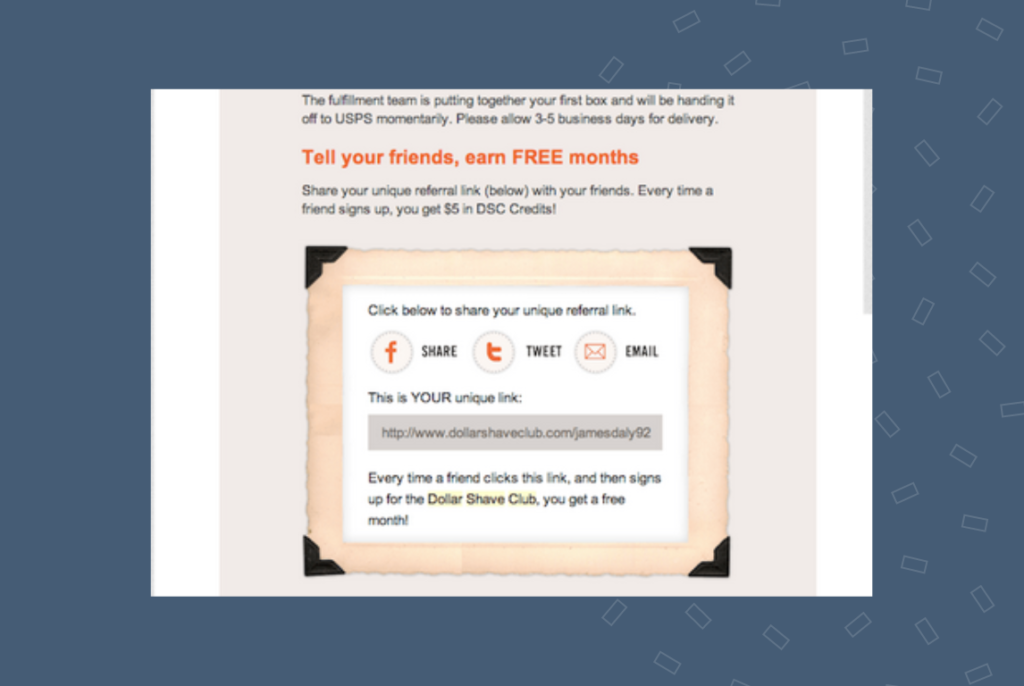
Dollar Shave Club’s referral program is one-sided, meaning only the referrer receives a reward for using the program. So, only existing customer based, which is the DSC members, receive the $5 credit for every successful referral.
The Dollar Shave Club’s unique referral code example demonstrates how you can customize your referral codes and incentives within your business model.
Grow your customer base with effective referral campaigns
Want to see the impact of Birdeye on your business? Watch the Free Demo Now.
Craft referral codes that convert: Best practices + pro tips
Behind every great referral program is a code that’s easy to remember, simple to share, and built with purpose. While it’s tempting to generate random alphanumeric strings, the most effective referral codes are personalized, branded, and backed by a smart marketing strategy.
Here’s how to build codes that actually get used and how tools like Birdeye Referrals make the process seamless:
- Make your code meaningful and campaign-aligned: When creating referral codes, remember that they don’t need to be complicated but should be relevant. If you’re running a seasonal push, generate referral codes like “Festive15 or NewYear20.” They will always outperform random strings. Want a personal touch? Add the customer’s name for a code like Jess25. This helps both the advocate and their circle feel more connected to the brand.
- Keep it short and brand-friendly: The goal is recall and ease. A long code defeats the purpose, especially when compared to a clickable link. Aim for 10–15 characters max and avoid special characters unless they align with your identity.
- Use time limits and exclusivity to drive urgency: Limited-time or one-time-use codes add urgency and reduce the risk of misuse. Let users know when the code expires or limit how many times it can be redeemed. This creates a sense of exclusivity and encourages faster action.
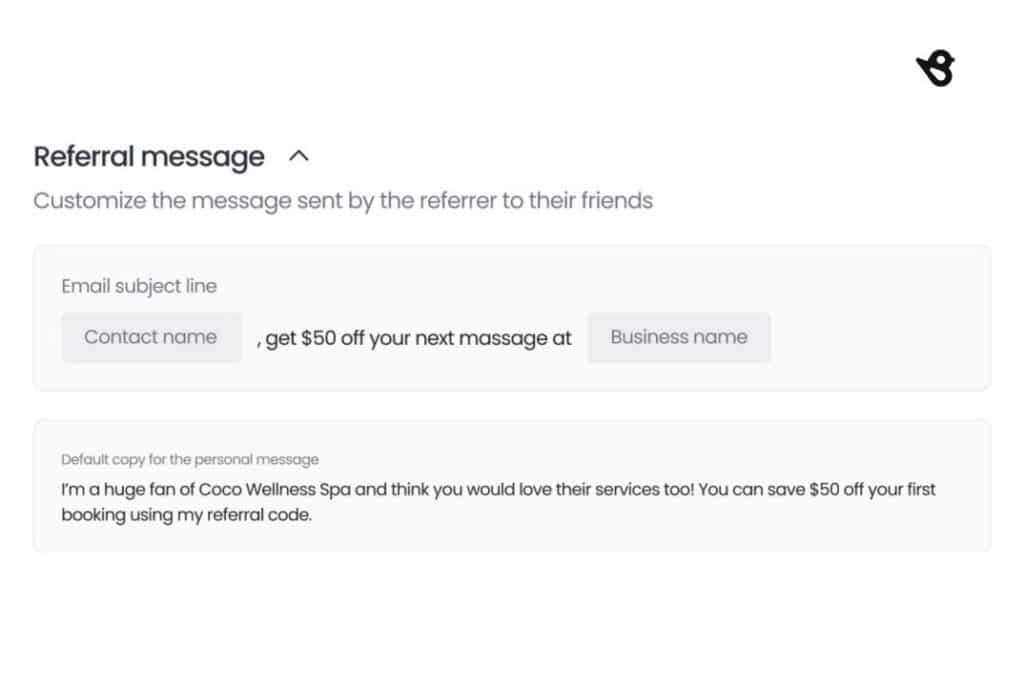
- Ensure it’s trackable and scalable: Every time you use referral codes, you’re creating a valuable data point. With tools like Birdeye, you get built-in referral tracking, so you can see which codes are driving conversions and which customers are bringing in the most new referral customers.
- Use templates to save time and stay consistent: Instead of building codes and campaigns from scratch, use Birdeye’s branded templates for referral messaging, design, reward structure, and forms. Whether it’s for a one-off campaign or an ongoing two-sided referral program, templates help you operate at scale without sacrificing personalization.
- Add compelling incentives to boost conversions: The best referral marketing campaigns aren’t just easy; they’re rewarding. With Birdeye Referral Rewards, you can offer incentives like cash, gift cards, or coupon codes to both the sender and recipient. When both the referrer and their friend get value, participation skyrockets.
- Streamline your entire referral process: Building a referral code is one part, the other is making it easy to share. With Birdeye, customers can send discount codes via email, text, or even social media. This effortless sharing instantly turns them into advocates.
When powered by the right tools and marketing strategy, your referral codes become more than identifiers; they become growth drivers. With Birdeye Referrals, creating high-converting codes is faster, easier, and completely aligned with your brand.
How to ace referral marketing with ease?
While creating a refer-a-friend program is the first step, getting people to actually use it takes more than just rewards.
Here’s how to turn your program into one of the successful referral programs in your space:
- Start with a customer-first mindset: Before asking for referrals, make sure your customer journey is rock solid. Every touchpoint, from onboarding to support—should exceed expectations. Happy customers are far more likely to share your business with others. A seamless experience is the foundation for any two-sided referral program to succeed.
- Identify your happiest customers: Use customer reviews, testimonials, and survey feedback to spot your most satisfied users. These promoters are your biggest advocates, and they’re most likely to refer others. Just like the Coinbase referral program, which grew massively by targeting engaged users with incentives, your outreach should focus on people who have already bought into your brand.
- Time your ask and personalize the message: A generic “refer us” message won’t cut it. Tailor your referral requests based on actions like a 5-star review or a recent successful interaction. Make it feel personal and timely, like a natural extension of your ongoing conversation.
- Use smart referral software to optimize performance: Tools like Birdeye Referrals help you automate and personalize every step of the referral journey. You can track how well your referral program works, see which messages convert best, and offer compelling incentives to boost customer acquisition. Plus, it supports fully customizable campaigns, whether you’re launching a seasonal push or running a long-term loyalty strategy.
- Reward both sides to increase conversions: A two-sided referral program where both the referrer and the new customer benefit has proven to outperform single-sided ones. Whether it’s a discount, gift, or credit, rewarding both parties builds goodwill and encourages repeat participation.
Final takeaway: Build trust, get leads, repeat
Referral marketing is a unique combination of trust, loyalty, and social proof that fuels sustainable growth. The success of the top brands shows that when done right, referrals can outperform even your best-paid campaigns.
Every time a referred friend signs up or makes a purchase, you earn a vote of confidence that builds long-term credibility. But here’s the key: for this strategy to scale, you need more than just a good idea. You need the right infrastructure.
Whether you follow Airtable, Dropbox, or Coinbase’s referral programs or create your own, the best ones deliver clarity, simplicity, and delight.
With the right tools and a clear strategy, your referral program can become more than a channel; it can become your most powerful engine for word-of-mouth growth.
FAQs about referral code examples
You can manually create a referral code for each campaign or use referral program software to automatically generate and track those referrals.
The four types of referrals include direct, email, incentive-based, and referrals from online reviews. Referral codes can help with all of them.
Share your referral code by simply sending them a link with your referral code. Copy and paste the link directly into an email, text, or social media message.
Your referral code is visible inside or embedded within your referral link. Usually, the referral code shows up at the end of the referral link string of characters.
A referral code link is a referral code (a unique identifier) that is part of a referral link. The code allows businesses to track the referral to know the actual referrer. The link allows customers easy access to participate and share.
Grow your referral program with Birdeye
Referrals are the backbone of every business. They ensure that the effort you put into customer experience is rewarded with more customers. That is why you need strong referral marketing software like Birdeye to manage it for your business.
With Birdeye, you can:
- Build custom referral program automation and ensure every customer gets a request
- Send and track referral code requests across customer communication channels
- Create customizable templates (messaging, design, etc) to match your brand and campaign goals.
- Connect with new referral customers instantly and take the conversation ahead
- Monitor which customer gets the maximum referrals and reward them accordingly
- Integrate with over 3000 CRMS and PMSs, and other tools to track conversions.
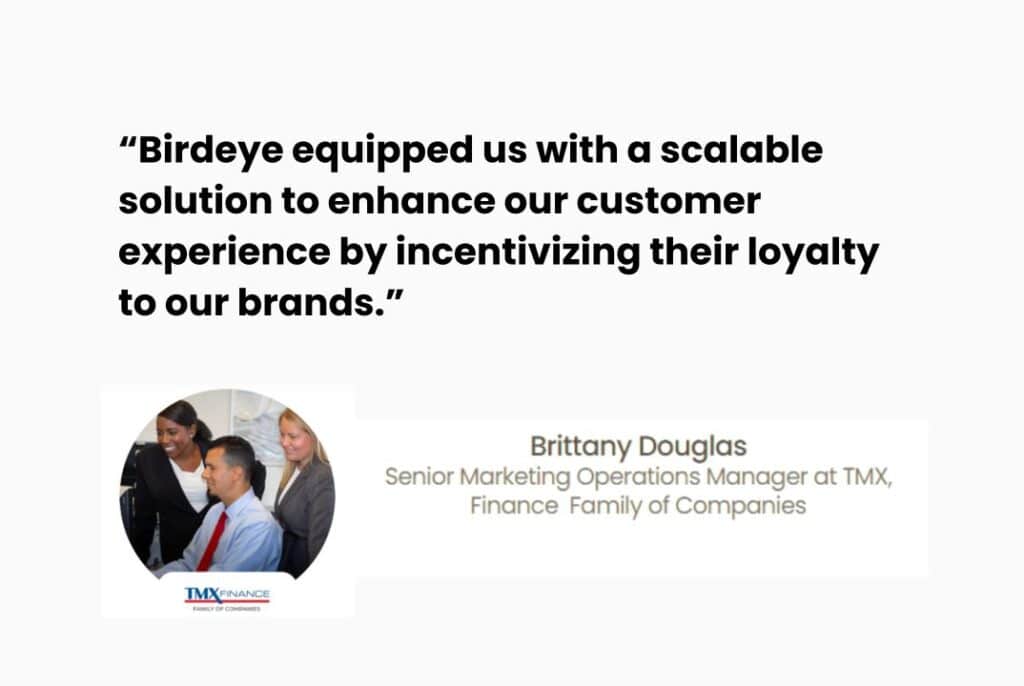
Ready to launch a successful referral program? Get started with Birdeye today. Watch a demo now.

Originally published

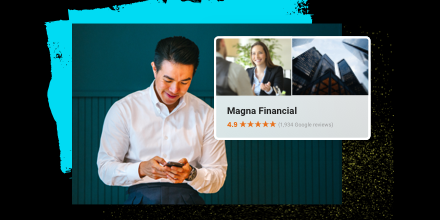


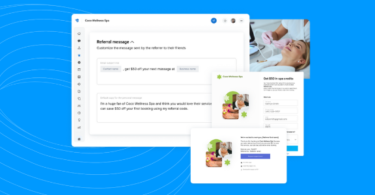
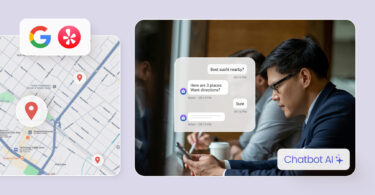
![[Feature image] The best AI tools for business in 2025 A complete guide for productivity, content, and growth](https://birdeye.com/blog/wp-content/uploads/Feature-image-The-best-AI-tools-for-business-in-2025-A-complete-guide-for-productivity-content-and-growth-375x195.jpg)
